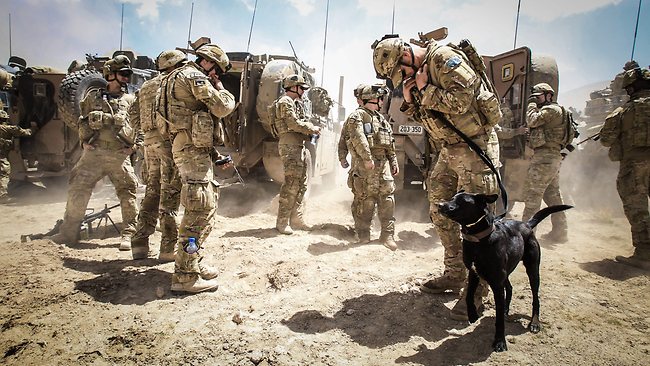2nd Battalion, The Royal Australian Regiment
A Brief History – 2RAR· Page
Ctrl+K
A Brief History
This site does not attempt to write the history of the 2nd Battalion, The Royal Australian Regiment (2 RAR) but aims to give a brief insight to the history and traditions earned by the service of those who have gone before.
- South West Pacific 1945
- Japan 1946-1948
- Australia 1948-1953
- Korea 1953-1954
- The Hook
- Australian 1954-1955
- Malaya – First Tour
- Malaya – Second Tour
- Vietnam – First Tour
- Vietnam – Second Tour
- Re-Raising of 2 RAR
- United Nations Assistance Mission in Rwanda (UNAMIR)
- East Timor
- Solomon Islands
- Iraq
- Afghanistan
- Current Operations
South West Pacific 1945
2 RAR had its origins as 66 Aust Inf Bn, which was raised on 16 Oct 45 at Labuan in Borneo before joining 34 Aust Inf Bde on the island of Morotai in the Molluccas archipelago of Indonesia. Volunteers for the Battalion came mostly from men of the 9th Division, 2nd AIF.
Japan 1946-1948
The Battalion participated in the occupation of Japan as part of 34 Aust Inf Bde from Feb 46 to Dec 48. The 66th Battalion was stationed at Hiro during this time but was also temporarily garrisoned at Tokyo and Ebisu as part of its occupation duties.
On 23 Nov 48 the 66th Battalion became the 2nd Battalion, The Australian Regiment.
Australia 1948-1953
In Dec 48 the unit returned to Australia and was located at Puckapunyal in Victoria. The Battalion became the 2nd Battalion, The Royal Australian Regiment on 10 Mar 49 with approval being given to add the prefix ‘Royal’ to the existing title. 2 RAR remained at Puckapunyal until Mar 53 as part of 1 Independent Infantry Brigade Group. It was responsible for the training of recruits from the Southern States; and later, recruits for the Battalions fighting in Korea.
Korea 1953-1954
On 5 Mar 53 the Battalion embarked for Pusan, Korea on MV ‘New Australia’ and arrived on 17 Mar 53. A soldier named Private G Belville stowed away on board because he had been posted out of the unit a few days before. He was fined five pounds and taken back on strength. In 1957, on graduating from OCS, he served as an officer in the Battalion for a short period. He was killed in action in 1966 as a Captain serving with the Army Training Team in South Vietnam.
On 21 Mar 53 detachments from 1 RAR, 2 RAR and 3 RAR paraded together on the 1 RAR parade ground at Camp Casey. This was the first occasion in which all the Battalions of The Royal Australian Regiment had paraded together and on this occasion all were on war service. In Apr 53 the Battalion moved into the line, as part of 28 BRITCOM Bde/1 COMWEL Div, relieving a French Battalion. It was noted that artillery and mortar reports became more timely and accurate from the rifle companies after mortar fire had damaged C Company’s beer ration in early May 53.
The Hook
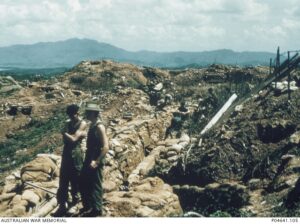
Australian soldiers of 2RAR stand above their front line trenches at the Hook feature.
Soldiers from 2RAR smile as they get news of the Korean War ceasefire, signed on July 27, 1953.
On 9 Jul 53 2 RAR relieved the 1st Battalion, The King’s Regiment around ‘The Hook’ feature, the left flank of 1 COMWEL Div. The Battalion was subjected to intermittent artillery, mortar and
infantry attacks leading up to the battle of ‘The Hook’ on 24, 25 and 26 Jul 53. Coinciding with attacks on 7 US Marine Regt, on the Battalions left, 2 RAR was heavily attacked with artillery concentrations and infantry during the night of the 24th and the early hours of the 25th Jul. The reserve company from 1 Durham Light Infantry (DLI) came under command 2 RAR at midnight. The enemy objectives were the feature ‘Boulder City’ in the US Marine Sector and ‘POINT 121’ in the 2 RAR Sector. All attacks were repulsed with heavy enemy casualties by the morning of the 25th and the reserve company from 1 DLI was withdrawn.
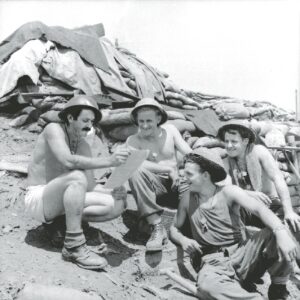
The enemy resumed heavy attacks on the Marines and the 2 RAR sector during the night of the 25th. D Company, 3 RAR came under command at 0100 hours and again a company from 1 DLI was warned but did not move up. These attacks were again beaten back with severe enemy casualties and major attacks ceased by the morning of the 26th. For its performance under these attacks 2 RAR won the battle honour ‘SAMICHON’.
Australian 1954-1955
The Battalion sailed for home on 6 Apr 54 on MV ‘New Australia’, arriving at Brisbane on 16 Apr 54 and moved into Enoggera Barracks. The Jungle Training Centre had recently been re-established at Canungra near Brisbane and 2 RAR was the first unit to pass through this reactivated centre.
The Governor-General Field Marshal Sir William Slim, GCB, GMG, GCVO, GBE, DSO, MC, KStJ presented colours to the Battalion at Victoria Park, Brisbane on 28 Sep 55. The Battalion then became the first regular unit in Australia to receive the Queens’ and Regimental Colours. After receiving the Colours the Battalion marched through Brisbane, its last public appearance before proceeding overseas again.
Malaya – First Tour
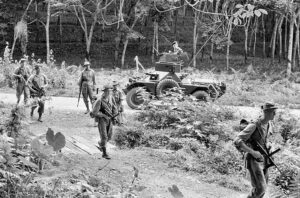
2RAR on patrol in Perak
The Battalion was the first Australian unit to serve in Malaya since World War II. It was also the first time for Australian troops to become members of an overseas, operational part of the British Commonwealth Far Eastern Strategic Reserve. 2 RAR embarked in Brisbane in Oct 55 and moved to Penang as part of 28 COMWEL Ind Inf Bde. It is noteworthy that the formation in which the Battalion served had the longest title in any Commonwealth Army: ’28 British Commonwealth Independent Infantry Brigade Group’ (North Malay Sub-District).
The Battalion entered operations on 3 Jan 56 in the Kulim area. B Company had the first successful contact with the Communist Terrorist (CT) enemy during ‘Operation Deuce’. During this operation a party of Sarawak Rangers were attached as scouts and proved very valuable. This operation concluded for the Battalion on 30 Apr 56 when a Battalion of the Malay Regiment relieved it.
2 RAR immediately participated in a 28 COMWEL Indep Inf Bde operation called ‘North Shark’ at Kuala Kangsar in the state of Perak. Extensive use was made of Auster Aircraft from 1907 LL/AOP FLT dropping supplies and mail, recon and liaison. Operations were continued at Sungei Siput from 27 Oct to 2 Dec 56.
The unit was withdrawn from ‘Operation North Shark’ for rest and retraining at Minden Barracks and was based at Penang. On 4 Feb 57 the unit returned to ‘Operation North Shark’ relieving the 1st Battalion, Royal Lincolns. Again Auster aircraft provided support against 13/15 Indep Pl (CT). The unit also participated in ‘Operation Rubberlegs’ from 7 Mar to 17 Mar 57. On 1 Aug 57 2 RAR moved back to Butterworth for rest and retraining and remained at Butterworth/Penang until late Oct 57.
During this tour official approval was received for the 2 RAR flag to be black, with the numbers to be in the upper hoist canton and The Regimental Crest in the centre. On 31 Oct 57 the Battalion returned to Australia and marched through Sydney to a ticker-tape welcome from 100,000 spectators. 2 RAR returned to barrack life at Holsworthy, again as part of 1 Indep Inf Bde Gp. In mid – 1960, after a major reorganisation of the Army, the Battalion became a Pentropic unit. It was reorganised on tropical establishment again in Jun 61 to prepare for its second tour of Malaya.
Malay – Second Tour
The Battalion was the first to serve two tours of Malaya. It joined 28 COMWEL Indep Inf Bde Gp at Terendak Camp near Malacca in Oct 61. During this tour it hunted the remnants of the communist terrorists on the Thailand/Malaysia border. The Battalion returned to Brisbane and Enoggera Barracks in August 1963 without suffering any loss of life. The unit then served as part of the 6th Task Force, 1 Div.
Vietnam – First Tour
2 RAR remained at Enoggera until it embarked for operational service in South Vietnam on 19 May 67. On that day the unit sailed on the troop carrier HMAS Sydney to relieve the 6th Battalion
Soldiers of 11 Platoon D Company await extraction by helicopter
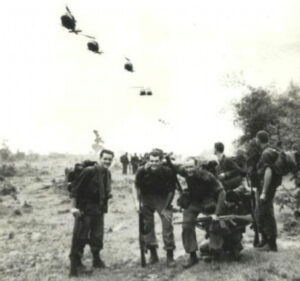
serving with the 1st Australian Task Force at Nui Dat in Phuoc Tuy Province. During this tour two companies of New Zealand Infantry were placed under command and 2 RAR became an ANZAC Battalion. Soldiers of 2 RAR/NZ (ANZAC) took part in 23 operations in Phuoc Tuy and Bien Hoa Provinces and maintained constant patrols and ambushes throughout their area of operations. Nine of these operations were conducted wholly by the ANZAC Battalion. Others were staged with 3 RAR, 7 RAR with armour, artillery, engineer, aviation and SASR support.
The Battalion’s most successful operation was Operation ‘Coburg’ that took place in the area of the border between Bien Hoa Province and Long Kanh Province north west of Phuoc Tuy Province. This was a Task Force operation, the first in strength outside Phuoc Tuy Province. This Task Force relieved the 199th Inf Bde (US) with the aim of denying the Viet Cong (VC) access to the area and sites from which they could direct rocket fire into the huge American bases at Long Binh and Bien Hoa. During the operation the enemy launched the Tet Offensive.
The number of contacts with the enemy rose sharply and instead of local force VC the unit began to meet well trained main force troops of 274th VC Regiment. 91 VC or North Vietnamese were killed and over 80 weapons captured.
In this first tour the ANZAC Battalion killed 187 enemy, inflicted a further 60 confirmed WIA casualties, captured 12 prisoners and 190 weapons. The Australians and New Zealanders had 29 soldiers killed during the tour. 4 RAR relieved the Battalion 1 Jun 68. On its return from Vietnam on 13 Jun 68 the Battalion again occupied an area of Enoggera Barracks prior to establishing itself at Lavarack Barracks, Townsville in Jun 69.
Vietnam – Second Tour
On 15 May 70, 2RAR relieved 6RAR and resumed the title of ANZAC Battalion. Three Australian rifle companies plus V and W Companies, additional Support Company elements and a Bn 2IC from New Zealand completed the Battalion. A significant percentage of those on the Manning Chart had been there before.
During the Tour, the Battalion embarked on seven operations. Except for a two-week break in September all of the ops were back to back so the pace throughout was intense. Their enemy was primarily LF. Both Battalions D440 and D445 were encountered as well as D65 Engineers NVA and the Chau Duc District HQ and LF Company. An additional task of training and operating with Regional forces and a neighboring Thai Battalion was successful but too short lived to influence events long term. The support for those activities had to come from largely within the Battalion and was conducted in tandem with the Battalion’s normal operations.
There were 14 names added to the Battalion’s Honour Roll by the end of the tour. These comprise eight Australians and six New Zealanders. Booby traps and mines accounted for most of these and as well there were several accidental deaths.
4RAR/NZ (ANZAC) took over operational responsibility from 2RAR in May 71. The Battalion returned to Lavarack Barracks where it linked with 4RAR on 15 Aug 73.
There can be no doubt that to maintain such an intensity of operations over the period that the leadership and tactical skills of the Battalion was of a high standard. Not only at the officer level but particularly so at the WO, senior NCO and junior NCO level. In fact it was Second to None.
Re-Raising of 2 RAR
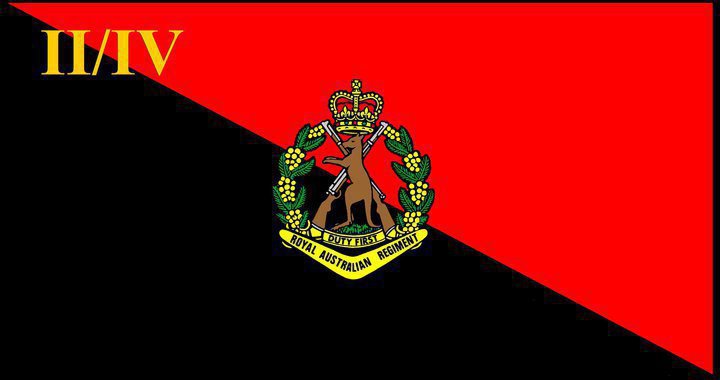
On 1 February 1995, after more than twenty-one years linked together, the 2nd and 4th Battalions of The Royal Australian Regiment were unlinked. In a reversal of the Post-Vietnam policy that resulted in the original linking of the two battalions, the Australian Government determined that the Army required an additional infantry battalion in order to meet the nation’s defence commitments. As a result, the Chief of General Staff directed that 2/4 RAR unlink, with the “new” 2 RAR remaining in Samichon Lines and 4 RAR re-raised at Holsworthy Barracks in Sydney. With A Coy deployed in Rwanda, D Coy on a Butterworth rotation in Malaysia and Spt Coy in Shoalwater bay, ceremonies were held in Africa, Asia and Australia to commemorate the event.
United Nations Assistance Mission in Rwanda (UNAMIR)
In 1993, the United Nations Assistance Mission in Rwanda (UNAMIR) was raised and tasked to supervise the transition from sectarian civil war to peace. The peace process rapidly deteriorated in the early months of 1994 after the Rwandan President was killed when his plane was shot down. Within hours, Hutu extremists seized control of the Rwandan government and began instigating genocide. A Coy 2/4 RAR deployed as part of the Australian Medical Support Force (AUSMED) under the command of LTCOL Patrick McIntosh. This force element was charged with protecting the Australian medical personnel operating out of the badly damaged, Kigali Central Hospital.
In February 1995, B Coy 2 RAR deployed as part of the second contingent commanded by COL Peter Warfe. It was during this deployment that B Coy members witnessed the full horror of the genocide at Kibeho refugee camp. As the situation in the camp deteriorated, the AUSMED was tasked to provide medical support to the Zambian troops stationed there. From 20 to 23 April, the RPF began to close down and empty the camp. The situation soon descended into a violent massacre as the RPF mercilessly killed around 4,000 people and injured a further 600. LT Steve Tilbrook, who commanded 2 RAR’s contingent present during the massacre, ordered his men not to open fire in defence of the refugees. His reasoning was twofold; the RPF heavily outnumbered Australian forces, and he suspected that Australian bullets may cause further civilian death amidst the mayhem. CPL J.C. Blake of 5 Pl was quoted in the 1995 Battalion magazine as saying, “Walking through the masses of dead and wounded, overwhelmed with horror and disbelief. My section on return to the compound, each man wide eyed and pale. We all sat in silence.”
East Timor
On 15 September 1999, the United Nations Security Council responded to the rapidly deteriorating situation in East Timor by authorising the deployment of a peace enforcement force, acting under Chapter 7 of the UN Charter. On 20 September 1999, the International Force in East Timor (INTERFET) deployed under the command of Australian Major General Peter Cosgrove. 2 RAR was the first Infantry battalion to land at Comoro Airport and quickly acted to secure the APOD and SPOD in order facilitate the arrival of 3 RAR on 21 September. The two battalions commenced the process of restoring law and order in Dili through patrolling, VCPs, and the disarming and apprehension of militia members. The precariousness of the situation became blatantly apparent as members of 2 RAR routinely discovered evidence of murdered and mutilated civilians in the streets of Dili.
After a Brigade sweep of Dili achieved its intent of securing the city, the Battalion shifted its efforts to the western border region. On 1 October 1999, Operations Lavarack and Chermside saw the Battalion secure the towns of Balibo and Maliana, respectively. On 10 October, C Coy, with elements of Spt Coy, conducted a patrol to follow up reports of TNI and militia ill-treating the locals in the village of Motaain. During their approach into the village, 8 Pl C Coy was engaged by automatic fire from militia elements. The platoon returned fire, killing a POLRI sergeant and seriously wounding 2 others. The militia fled through the TNI and CPL Paul Teong, 2 RAR’s lead section commander, was awarded the DSM for exemplary leadership under fire.
After being replaced in the northern border region by 5/7 RAR on 2 January 2000, 2 RAR finished its tour and returned to Townsville. However, the Battalion would return to East Timor for six months, from October 2001 to April 2002. The Second Battalion Group served in the Bobonaro District of East Timor as part of the United Nations Transitional Administration in the newly independent nation. A vast majority of the group was part of the initial Australian force that landed on the first day of the INTERFET campaign just two years earlier.
The Battalion would redeploy three times. During this period, Timor was renamed Timor Leste. Two of these commitments occurred under a new UN mission, the United Nations Integrated Mission in East Timor (UNMIT). This mission was established after the Timorese government requested assistance in the midst of increased violence as a result of serious social, political and ethnic tensions. The Battalion deployed for a period of six months in 2006 and again in October 2007. On 5 November 2007, 2 RAR suffered its only loss in Timor Leste, PTE Ashley Baker. The Battalion’s final deployment to Timor Leste was for a period of nine months, commencing in May 2009. This deployment was characterised by cooperation with NZ and US forces, low-level presence patrols and indigenous capacity building.
Solomon Islands

By early 2003, a cocktail of ethnic tensions, a breakdown in law and order, and the near collapse of the economy had rendered the Solomon Islands a failing state. On 22 April 2003, the prime minister of the Solomon Islands requested Australian assistance to restore peace and stability. A reinforced company group from 2 RAR was deployed in July 2003 as part of The Regional Assistance Mission to Solomon Islands (RAMSI) to support the civilian police in re-establishing law and order. The Battalion subsequently deployed on Operation Anode on two further occasions, the first in November 2003 and the second in May 2004.
Iraq
In March 2003, the United States assembled a ‘coalition of the willing’ to invade Iraq, depose the supposedly Al’Qaida-linked Saddam Hussein, and expel the Ba’athist regime. While the invasion was originally premised upon the existence of weapons of mass destruction, operations in Iraq would soon evolve in response to the anti-American insurgency, sectarian divides and gruesome civil war. Due to the persistent and dynamic nature of the Iraq War, the ADF’s contribution lasted ten years, from 2003 to 2013. During this period of unparalleled operational tempo, elements of the 2nd Battalion supported operations on four separate occasions.
The battalion’s first two deployments came as part of Security Detachment Iraq (SECDET Iraq). SECDET was typically based upon an Australian Army combined arms combat team consisting of an Infantry company group and a cavalry troop. The force’s duties included static security guarding at the Australian Embassy in Baghdad and the protection of Australian diplomats and vehicle convoys. In May 2003, the Battalion contributed 5 Pl B Coy to SECDET I, while the entire A Coy deployed on SECDET II later that year. The Battalion’s fifth and final contribution to the War in Iraq was to SECDET XV in 2009. B Coy HQ and two platoons were joined by a LAV troop from the 2nd Cavalry Regiment, elements of the 1st Military Police Battalion and a CSS element.
In addition to the aforementioned SECDET rotations, 2 RAR contributed elements to the Al Muthanna Task Group (AMTG) in May 2006. The AMTG was a battlegroup that formed Australia’s main ground force contribution to the multinational force in Iraq. The AMTG had two key tasks: provide security for the Japanese Iraq Reconstruction and Support Group (JIRSG), and assist in the training of local Iraqi forces. The then CO, 2 RAR, LTCOL Michael Mahy, commanded A and Spt Coys, A Sqn 2/14 Light Horse Regiment, and an IMV detachment from 6 RAR.
Afghanistan
Elements of the Battalion have deployed to Afghanistan on two occasions. The first came in October 2007 when the bulk of the Battalion was in Timor Leste, while the second came in June 2011 when the whole Battalion was committed as a Mentoring Task Force.
The Battalion first deployed to Afghanistan on Operation Slipper as part of RTF-3. The Security Task Group (STG) was made up of infantrymen from C Coy, mortar-men and snipers from Support Coy, and supporting elements from 6 RAR, 3/4 Cavalry Regiment, 2/14 Light Horse Regiment, and 4 Field regiment. Elements from these units combined with elements of 3 CER to form Combat Team Spear. The role of the STG was to provide the firepower and mobility necessary to facilitate the engineers’ protected reconstruction.
The Battalion conducted five major operations during its deployment, effectively expanding the ISAF and ANSF’s permanent influence in the Chora Valley and into the Baluchi Pass. Combat Team Spear sustained casualties early in the deployment with TPR David ‘Poppy’ Pearce being killed by an IED and SGT Michael Lyddiard being seriously wounded whilst defusing an IED in the Chora Valley. Nevertheless, the Combat Team was able to take the fight to the enemy during several engagements, most notably in the Sorkh Morghab region. During this engagement, elements of 2 RAR distinguished themselves whilst fighting the enemy over several days in order to support the construction of a patrol base in an area previously considered a Taliban stronghold.
In June 2011, the Battalion deployed to Urozgan Province to lead Mentoring Task Force 3 (MTF3). This deployment succeeded in its aim of improving the Afghan National Army’s (ANA) capability and confidence. The result of MTF-3 was increased security across a larger footprint in Urozgan Province. Commanding Officer, Lieutenant Colonel Chris Smith, said when MTF-3 arrived in June 2011, that the ANA was conducting around 25 activities on its own across the Brigade each week. By the end of the Battalion’s tour, that number had grown to around 100 independent activities a week. Sadly, these gains did not come without sacrifice. Three MTF-3 soldiers were killed in action. Private Matthew Lambert (2 RAR) died from wounds sustained in an IED strike on 22 August 2011, while Lance Corporal Luke Gavin (2 RAR) and Captain Bryce Duffy (4 Regt) were killed in action when an ANA soldier opened fire at Forward Operating Base Sorkh Bed on 29 October 2011.
Current Operations
Amphibious Trial Battalion
As part of Plan Beersheba, which was announced in late 2011, the 2nd Battalion was entrusted as Army’s dedicated amphibious trial battalion – forming the core of the ground combat element (GCE) of the ADF’s amphibious landing force. The Battalion has played a pivotal role in raising the ADF’s amphibious capability following the purchase of Landing Helicopter Docks, HMAS Canberra and HMAS Adelaide. The Battalion has negotiated the complexities involved with raising a new capability over numerous amphibious exercises, including Exercise RIMPAC 16, and successfully conducted Humanitarian and Disaster Relief activities during Operation Fiji Assist in early 2016.
Regimental Badge
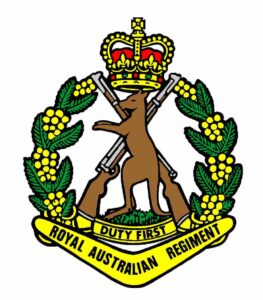
The design of the regimental badge was selected from a number of suggestions considered by the Director of Infantry, Brigadier I.R. Campbell in early 1949.
The design was drawn up by Sergeant E.J. O’Sullivan of 1 RAR Intelligence Section and had originally been intended for 1 RAR only.
The design featured the kangaroo and wattle wreath as distinctly Australian symbols; the boomerang, which had been used in the tactical signs of the 2nd AIF from which the original units of 34 Brigade were raised; the crossed rifles signifying the personal weapon of the infantryman; and the crown because of the royal title of the Regiment. Major K.B. Thomas MC of 1 RAR suggested the simple but highly appropriate motto ‘Duty First’. This motto was adopted and included on the badge.
Although the badge was reproduced on Christmas cards in 1949, it was not until early 1954 that the hat badge was issued to replace the rising sun badge.
Appendixes:




